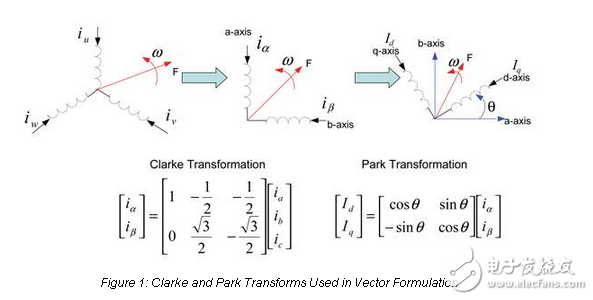
资料下载

三相电机控制:瑞萨RX系列单片机浮点优于固定点
三相电机控制:瑞萨RX系列单片机浮点优于固定点
与传统的定点MCU解决方案相比,浮点硬件单元被添加到CPU核心,用于执行指令,从而提高了电机的控制效率。
随着人们越来越注重使用节能技术,工程师们越来越多地将他们的控制设计转移到更高效的三相无刷直流电机(BLDC)和永磁同步电机(PMSM)。这些电机的电机控制算法通常采用矢量和无速度传感器矢量控制,涉及复杂的变换和控制回路的速度和位置。工业应用通常采用基于传感器的控制,因为需要更高的精度,而消费产品应用由于其成本敏感性质,一般使用无传感器配方。
矢量控制为电机速度和转矩提供高效精确的控制。这是通过将三相交流电动机的定子电流解耦为磁链分量和转矩分量来实现的。其结果是,转矩和磁通可以直接控制(类似于直流电动机),以便快速动态响应和良好的稳态性能可以实现。事实上,矢量控制使无刷直流电机驱动器的性能可以媲美,甚至优于DC电机驱动器。

Sensorless vector control (SVC), which reduces cost by eliminating the speed sensor from the design, makes estimates of the motor’s speed and the position of the rotor from the observed stator currents. SVC uses complex coordinate transformations and motor mathematical models, which require a great deal of calculation. Thus SVC, like VC, necessitates a fast MCU with high computing capability.
Until recently, several factors prevented these advanced motor control techniques from gaining wider acceptance: (1) complicated theoretical mathematical modeling, (2) involved implementation strategy, and (3) traditional micro controllers (MCU) and Digital Signal Processors (DSP) implementing vector control. MCUs and DSPs use fixed-point formulation because these devices usually do not have a hardware floating-point unit (FPU)。
声明:本文内容及配图由入驻作者撰写或者入驻合作网站授权转载。文章观点仅代表作者本人,不代表电子发烧友网立场。文章及其配图仅供工程师学习之用,如有内容侵权或者其他违规问题,请联系本站处理。 举报投诉
- 相关下载
- 相关文章






